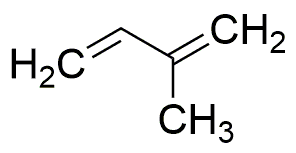Isoprene (stabilized with TBC) is widely utilized in research focused on:
- Rubber Production: It is a key ingredient in the manufacture of synthetic rubber, particularly in the production of polyisoprene, which is used in tires, footwear, and various automotive parts.
- Adhesives and Sealants: Isoprene is used to create high-performance adhesives and sealants that are essential in construction and automotive industries, providing strong bonding and flexibility.
- Biochemical Research: In laboratories, it serves as a building block for synthesizing various organic compounds, aiding researchers in developing new materials and pharmaceuticals.
- Flavor and Fragrance Industry: It is utilized in the production of certain flavoring agents and fragrances, enhancing the sensory attributes of food and personal care products.
- Polymer Manufacturing: Isoprene is crucial in creating specialty polymers that exhibit unique properties, making them suitable for applications in electronics and medical devices.
General Information
Properties
Safety and Regulations
Applications
Isoprene (stabilized with TBC) is widely utilized in research focused on:
- Rubber Production: It is a key ingredient in the manufacture of synthetic rubber, particularly in the production of polyisoprene, which is used in tires, footwear, and various automotive parts.
- Adhesives and Sealants: Isoprene is used to create high-performance adhesives and sealants that are essential in construction and automotive industries, providing strong bonding and flexibility.
- Biochemical Research: In laboratories, it serves as a building block for synthesizing various organic compounds, aiding researchers in developing new materials and pharmaceuticals.
- Flavor and Fragrance Industry: It is utilized in the production of certain flavoring agents and fragrances, enhancing the sensory attributes of food and personal care products.
- Polymer Manufacturing: Isoprene is crucial in creating specialty polymers that exhibit unique properties, making them suitable for applications in electronics and medical devices.
Documents
Safety Data Sheets (SDS)
The SDS provides comprehensive safety information on handling, storage, and disposal of the product.
Product Specification (PS)
The PS provides a comprehensive breakdown of the product’s properties, including chemical composition, physical state, purity, and storage requirements. It also details acceptable quality ranges and the product's intended applications.
Certificates of Analysis (COA)
Search for Certificates of Analysis (COA) by entering the products Lot Number. Lot and Batch Numbers can be found on a product’s label following the words ‘Lot’ or ‘Batch’.
*Catalog Number
*Lot Number
Certificates Of Origin (COO)
This COO confirms the country where the product was manufactured, and also details the materials and components used in it and whether it is derived from natural, synthetic, or other specific sources. This certificate may be required for customs, trade, and regulatory compliance.
*Catalog Number
*Lot Number
Safety Data Sheets (SDS)
The SDS provides comprehensive safety information on handling, storage, and disposal of the product.
DownloadProduct Specification (PS)
The PS provides a comprehensive breakdown of the product’s properties, including chemical composition, physical state, purity, and storage requirements. It also details acceptable quality ranges and the product's intended applications.
DownloadCertificates of Analysis (COA)
Search for Certificates of Analysis (COA) by entering the products Lot Number. Lot and Batch Numbers can be found on a product’s label following the words ‘Lot’ or ‘Batch’.
*Catalog Number
*Lot Number
Certificates Of Origin (COO)
This COO confirms the country where the product was manufactured, and also details the materials and components used in it and whether it is derived from natural, synthetic, or other specific sources. This certificate may be required for customs, trade, and regulatory compliance.


